Papers by Anastasia Chourmouziadi
Μουσeιακή eκπαίδeυση και eπικοινωνία σe μουσeία τέχνης και πολιτισμού [ΠΑΝEΠΙΣΤΗΜΙΟ ΘEΣΣΑΛΙΑΣ, ΣΧ... more Μουσeιακή eκπαίδeυση και eπικοινωνία σe μουσeία τέχνης και πολιτισμού [ΠΑΝEΠΙΣΤΗΜΙΟ ΘEΣΣΑΛΙΑΣ, ΣΧΟΛΗ ΑΝΘΡΩΠΙΣΤΙΚΩΝ ΚΑΙ ΚΟΙΝΩΝΙΚΩΝ EΠΙΣΤΗΜΩΝ, ΤΜΗΜΑ ΠΑΙΔΑΓΩΓΙΚΟ ΠΡΟΣΧΟΛΙΚΗΣ EΚΠΑΙΔEΥΣΗΣ]
Punctum. International Journal of Semiotics, 2017
Public Archaeology, 2009
Monitoring public perceptions of an ongoing archaeological project, although often discussed, is ... more Monitoring public perceptions of an ongoing archaeological project, although often discussed, is still a marginal activity, overshadowed by exca-vation and laboratory routines. The problem remains even if the research team is strongly orientated towards the ...
Open Science journal, Nov 24, 2021
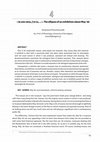
Social Sciences Today. Dilemmas and potential beyond crisis , 2021
Even if, for inexplicable reasons, some people love museums, they cannot deny that whatever is ex... more Even if, for inexplicable reasons, some people love museums, they cannot deny that whatever is exhibited in their halls is practically dead. Any object when musealized loses its relationship with the social context in which it was produced, consumed and imbued with meaning. This decontextualization constitutes the ontological basis of modern museums. Thus, museum objects are sterile and neutralized, open to authoritative interpretations and tools of educational strategies. Characteristics that led L. Althusser to include museums in the ideological apparatuses of the state. Consequently, a rebellion that enters a museum loses its revolutionary character whatsoever. Nevertheless, an exhibition, as a multimodal narrative practice does not necessarily have to be regarded as an exclusive tool of museums and can, therefore, explore other theoretical and methodological avenues and may be called upon to serve diverse social goals. The question on which this paper focuses is whether it is possible, outside the institutional, ideological and methodological boundaries of the modern museum, to utilize a range of exhibition narrative tools, not to tastefully present the dead shack of a revolt-to honor, as is usually the case, the past-, but to reopen a half-finished debate that is meaningful for the present.
Οι Κοινωνικές Επιστήμες σήμερα. Διλήμματα και προοπτικές πέρα από την κρίση, 2021
Κατά τη διάρκεια της προσφυγικής κρίσης που βιώνουμε τα τελευταία χρόνια, η αντίληψη που διαμορφώ... more Κατά τη διάρκεια της προσφυγικής κρίσης που βιώνουμε τα τελευταία χρόνια, η αντίληψη που διαμορφώνουμε για το πρόβλημα και για όλους όσοι εμπλέκονται με αυτό διαμορφώνεται όχι μόνο από τα όσα άμεσα αντιλαμβανόμαστε, αλλά και από τις αναπαραστάσεις που διοχετεύονται στη δημόσια σφαίρα.
Το κείμενο αυτό, συνδυάζοντας τα στοιχεία μελετών που αφορούν επιμέρους φωτογραφίες, σύνολα και εκθέσεις, επιχειρεί ένα γενικό σχολιασμό των εικόνων της προσφυγικής κρίσης και το πώς αυτές πλαισιώνουν το ζήτημα.
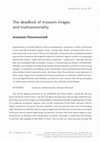
Punctum, 2017
Musealisation as tool for collective memory management, constitutes a violent intervention in the... more Musealisation as tool for collective memory management, constitutes a violent intervention in the social life of material objects, which –among other things-transforms them into almost exclusively visual stimuli. This loss of materiality contravenes the consolidated museum practice that is based on the tangible evidence of 'authentic' objects, as well as its undoubted educational mission. I argue that the triptych 'protection – authenticity – learning' that has been the ontological base of modern museum is characterized by inherent contradictions. Therefore, any attempt to re-determine museum practice should reexamine it. In this vein of thought, it is imperative to challenge vision's domination, using something more than limited naïve dashes of other sensorial stimuli, that leave intact the dominant visual approach. In other words, I argue that multisensorial museum experience can threaten traditional muse-um's ontological features, and, therefore, can lead to a 'new' museum that will act principally as 'public space', and secondly, as the protector of a collection of dead things.
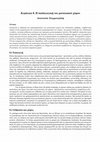
ΝΙΚΟΝΑΝΟΥ, Ν., ΜΠΟΥΝΙΑ, Α., ΦΙΛΙΠΠΟΥΠΟΛΙΤΗ, Α., ΧΟΥΡΜΟΥΖΙΑΔΗ, Α., ΓΙΑΝΝΟΥΤΣΟΥ, Ν. 2015. Μουσειακή μάθηση και εμπειρία στον 21ο αιώνα. [ηλεκτρ. βιβλ.] Αθήνα:
Σύνοψη Εξετάζεται η επίδραση των χαρακτηριστικών του μουσειακού χώρου στις διαδικασίες μάθησης, λ... more Σύνοψη Εξετάζεται η επίδραση των χαρακτηριστικών του μουσειακού χώρου στις διαδικασίες μάθησης, λαμβάνοντας υπόψη γενικά μορφολογικά και λειτουργικά χαρακτηριστικά του κτιρίου, τη χωρική ανάπτυξη των εκθεσιακών ενοτήτων, τη σχέση εκθέματος-κελύφους και επιμέρους μουσειογραφικές επιλογές. Θα ληφθούν υπόψη όσα έχουν διατυπωθεί στο πλαίσιο της εκπαιδευτικής θεωρίας αλλά και γενικότερα θεωρητικά σχήματα για τη χωρική σύ-νταξη, φαινομενολογικές προσεγγίσεις, αλλά και η δραστικότητα του μαθησιακού χώρου. Τα παραπάνω συσχετί-ζονται με διαφορετικά ενδεχόμενα της μαθησιακής διαδικασίας σε κλειστούς και ανοιχτούς μουσειακούς χώρους. Γίνεται αναφορά στην εξέλιξη των παραπάνω, ώστε η χωρική διάσταση της μουσειακής μάθησης να εντάσσεται στο ιστορικό πλαίσιο τόσο του μουσειακού φαινομένου όσο και της εκπαίδευσης. Έτσι, μπορεί να σκεφτεί κανείς μελλοντικούς σχεδιασμούς όπως επεμβάσεις σε υπάρχοντα μουσειακά περιβάλλοντα, διαμόρφωση νέων και τις δυνατότητες του εικονικού ψηφιακού χώρου. 8.1 Εισαγωγή Όποιο περιεχόμενο και αν δώσει κανείς στη μουσειακή δραστηριότητα –προστασία, μελέτη, έκθεση, διδασκα-λία, μάθηση, επικοινωνία, ψυχαγωγία–, δεν είναι δυνατό να τη φανταστεί έξω από τα φυσικά, αντιληπτικά, αισθητικά, λειτουργικά όρια ενός συγκεκριμένου χώρου. Οι δραστηριότητες και οι σχέσεις που προωθεί και οργανώνει, όπως άλλωστε και κάθε ανθρώπινη δραστηριότητα, χρειάζονται έναν χώρο για να αναπτυχθούν. Τα όσα συμβαίνουν στο μουσείο επηρεάζονται καθοριστικά από τα χαρακτηριστικά αυτού του χώρου, εμπλουτί-ζονται ή αντίθετα συνθλίβονται. Από την άλλη πλευρά, ο μουσειακός χώρος, όσο σταθερός και αν μας φαίνεται λόγω της υλικότητάς του, βαθμιαία αλλάζει, καθώς πάνω του εγγράφονται με περισσότερο ή λιγότερο σαφή τρόπο τα σημάδια της ανθρώπινης δράσης. Άνθρωποι, πράγματα και χώρος βρίσκονται σε μια συνεχή δια-πραγμάτευση και διαμορφώνουν από κοινού το γνωστικό αποτέλεσμα και τη μουσειακή εμπειρία στο σύνολό της. Αν εστιάσουμε λοιπόν στον εκπαιδευτικό ρόλο του μουσείου, είτε αυτόν τον αντιλαμβανόμαστε ως την αυτονόητη διαδικασία συγκρότησης της γνώσης στο πλαίσιο μιας οποιασδήποτε μουσειακής επίσκεψης είτε ως μια ειδικά σχεδιασμένη δραστηριότητα με συγκεκριμένους μαθησιακούς στόχους, οποιαδήποτε συζήτηση θα είναι ελλιπής, αν δεν λάβει υπόψη της πώς ο ρόλος αυτός διαμορφώνεται σε σημαντικό βαθμό και από τη χωρική παράμετρο. Για να προσεγγίσουμε το θέμα αυτό, θα πρέπει καταρχάς να έχουμε υπόψη μας ορισμένες βασικές δι-απιστώσεις που έχουν γίνει από τους μελετητές του χώρου –αρχιτέκτονες, κοινωνιολόγους, ψυχολόγους κλπ.– και αφορούν γενικά τη σχέση των ανθρώπων με τον χώρο μέσα στον οποίον ζουν. Επιπλέον, θα πρέπει να ανα-τρέξουμε στις πιο ειδικές παρατηρήσεις που έχουν διατυπώσει όσοι ασχολούνται συστηματικά με χώρους που έχουν σχεδιαστεί και χρησιμοποιούνται αποκλειστικά για εκπαιδευτικούς σκοπούς. Και φυσικά θα πρέπει να δώσουμε ιδιαίτερη σημασία στους μουσειακούς χώρους, ως μια ειδική κατηγορία που, πέρα από τον πανταχού παρόντα εκπαιδευτικό, φιλοδοξεί να εκπληρώσει και μια σειρά άλλων στόχων και η οποία περιλαμβάνει μια σημαντική ποικιλία κλειστών και ανοικτών χώρων, με σημαντικές διαφορές ως προς το μέγεθος, τη μορφή, την αισθητική αντίληψη, την εσωτερική οργάνωση κλπ. 8.2 Άνθρωποι και χώρος Το ερώτημα αυτό είναι τόσο παλιό και θεμελιώδες, που αν θέλαμε να το αναπτύξουμε διεξοδικά, θα έπρεπε να ξεκινήσουμε από τον Αριστοτέλη και να αφιερώσουμε πολλούς τόμους για να συμπεριλάβουμε, συνοπτικά έστω, όλες τις απόψεις που έχουν κατά καιρούς διατυπωθεί από ένα μεγάλο φάσμα μελετητών πολλών διαφο-ρετικών ειδικοτήτων. Αν δούμε μακροσκοπικά αυτή τη μακρά και ενδιαφέρουσα συζήτηση, θα μπορούσαμε επιγραμματικά να πούμε ότι σήμερα έχουμε εντελώς απομακρυνθεί από τις καρτεσιανές απόψεις που αντιμετώ-πιζαν τον χώρο ως ένα υλικό δοχείο, με μετρήσιμα φυσικά χαρακτηριστικά, μέσα στο οποίο «λαμβάνουν χώρα» οι ανθρώπινες δραστηριότητες. Όπως έχουμε απομακρυνθεί και από την καντιανή αντίληψη που θεωρεί τον χώρο μία κατασκευή του ανθρώπινου μυαλού. Όλοι οι μελετητές πλέον αποδέχονται τη δυναμική αλληλεπίδρα
Collections make connections. Αυτό είναι στα αγγλικά το θέμα της φετινής παγκόσμιας μέρας των μου... more Collections make connections. Αυτό είναι στα αγγλικά το θέμα της φετινής παγκόσμιας μέρας των μουσείων. Όταν το είδα μου δημιούργησε έναν έντονο προβληματισμό. Μετά το ξαναδιάβασα φωναχτά και διαπίστωσα ότι κάνει ρίμα. Σκέφτηκα ότι αυτό είναι θετικό στοιχείο για ένα θέμα. Ο προβληματισμός, παρόλα αυτά, παρέμεινε και αναρωτήθηκα αν το ομόηχο του πράγματος μπορεί αυτόματα να συνδέσει δύο έννοιες, όπως στα λογοπαικτικά αστεία του τύπου «το πεπόνι παγώνει, το παγώνι δεν πεπόνι».
Σ ε λ ί δ α | 1 ΕΝΑ ΕΙΚΟΝΙΚΟ ΜΟΥΣΕΙΟ ΓΙΑ ΤΟΝ ΘΕΟΦΙΛΟ ΧΑΤΖΗΜΙΧΑΗΛ Πριν ξεκινήσω να γράφω αυτό το κ... more Σ ε λ ί δ α | 1 ΕΝΑ ΕΙΚΟΝΙΚΟ ΜΟΥΣΕΙΟ ΓΙΑ ΤΟΝ ΘΕΟΦΙΛΟ ΧΑΤΖΗΜΙΧΑΗΛ Πριν ξεκινήσω να γράφω αυτό το κείμενο, έβαλα στην αναζήτηση του Google τη λέξη «museum» και μέσα σε ένα τρίτο δευτερολέπτου είχα 1.600.000.000 αποτελέσματα. Θεωρώντας ότι τα αποτελέσματα του Google αποτελούν τον καθρέφτη της καθημερινότητάς μας, μια πρώτη ενδιαφέρουσα παρατήρηση είναι ότι αν συγκρίνει κανείς τον παραπάνω αριθμό με τα 1.270.000.000 που μου πρότεινε ο αναζητητής για τη λέξη «Freedom» και τα μόλις 37.700.000 για την «democracy», διαπιστώνουμε ότι τα μουσεία φαίνεται να μας απασχολούν πολύ περισσότερο από την ελευθερία και τη δημοκρατία. Πράγμα παράλογο, και κάπως ανησυχητικό ακόμη και για μένα που τα μουσεία αποτελούν το αντικείμενό μου.
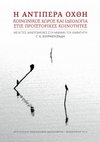
Η Αντίπερα Όχθη. Κοινωνικός χώρος και ιδεολογία στις προϊστορικές κοινότητες. Μελέτες αφιερωμένες στη μνήμη του καθηγητή Γ. Χ. Χουρμουζιάδη, 2019
During the last decades, more than a few papers have been underlining the clear political
charact... more During the last decades, more than a few papers have been underlining the clear political
character of archaeology, as a tool of modernity. The Greek case, constituting one of the most typical examples, has been thoroughly discussed. Nevertheless, the great majority of these texts have a, more or less, historical orientation, focusing on the procedures that led to the formation of the modern Greek state and on the 19th and early 20th century archaeological activity that supported the construction of Greek national narrative. In the text that follows, I attempt to briefly outline the basic features of the political economy of Greek archaeology, as it is exercised today, by the state services, the academia, and all those that, although deprived of an official archaeological position, still consider themselves archaeologists.
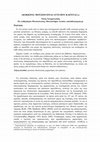
Σε ένα αστικό τοπίο από το οποίο έχει συστηματικά ξηλωθεί κάθε ιστορική μνήμη, τα μουσεία φυτρώνο... more Σε ένα αστικό τοπίο από το οποίο έχει συστηματικά ξηλωθεί κάθε ιστορική μνήμη, τα μουσεία φυτρώνουν, ως θύλακες μνήμης, ως άλλοθι απέναντι στη ληστρική διαχείριση του χώρου στα βήματα της μεταπολεμικής αντιπαροχής. Η λογική είναι απλή: όταν η ζώσα μνήμη είναι απειλητική για τις κοινωνικές ισορροπίες μουσειοποιείται, άρα ελέγχεται, και καθίσταται ανώδυνη μέσα στο αποστειρωμένο εκθεσιακό περιβάλλον. Άλλωστε, έχει διατυπωθεί επανειλημμένα ότι το μουσείο ως ιδεολογικός μηχανισμός του κράτους τεκμηριώνει και εικονογραφεί τις κυρίαρχες αφηγήσεις για το έθνος, κόβει και ράβει το παρελθόν στα μέτρα της άρχουσας ιδεολογίας, καλλιεργεί και αναπαράγει τα κάθε είδους κοινωνικά στερεότυπα.
Σήμερα, λοιπόν, σε συνθήκες μιας κρίσης που ολοένα και βαθαίνει, δημιουργώντας –ανάμεσα στα άλλα- την ελπίδα μιας ολόπλευρης ρήξης με τις δομές που μας οδήγησαν σε αυτή, τι θα κάνουμε με τα μουσεία; Υπάρχει περιθώριο να τα χρησιμοποιήσουμε ως πεδίο συλλογικής διαπραγμάτευσης του παρελθόντος και μοχλό κοινωνικής αφύπνισης, ή θα πρέπει να τα γκρεμίσουμε, όπως τη Βαστίλη, για να απελευθερώσουμε τις υλικές και άυλες μνήμες από τα ιδεολογικά δεσμά του «παλιού καθεστώτος»;
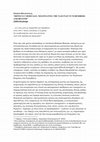
Τετράδια Μουσειολογίας 7, 2011
…κι α σου μιλώ με παραμύθια και παραβολές είναι γιατί τ' ακούς γλυκότερα, κι η φρίκη δεν κουβεντι... more …κι α σου μιλώ με παραμύθια και παραβολές είναι γιατί τ' ακούς γλυκότερα, κι η φρίκη δεν κουβεντιάζεται γιατί είναι ζωντανή γιατί είναι αμίλητη και προχωράει. 1 Όταν πριν από χρόνια επισκέφθηκα το Auschwitz-Birkenau Museum, οπλισμένη με την αντιναζιστική μου συνείδηση και την επαγγελματική μου μουσειολαγνεία, βίωσα μια εμπειρία την οποία δυσκολεύτηκα να διαχειριστώ και να αξιολογήσω. Ιδιαίτερα όταν βρέθηκα να συνωθούμαι στους θαλάμους αερίων 2 με καμιά εικοσαριά μαθητές που είχαν το κινητό συνεχώς στο αυτί τους και ανέλυαν θέματα που είμαι σίγουρη, αν και δεν ξέρω πολωνικά, ότι καμιά σχέση δεν είχαν με το χώρο ή το θέμα της περιήγησης. Από τότε, μαζί με την έντονη ανάμνηση; των συσσωρευμένων, εν είδει καλλιτεχνικής εγκατάστασης, τεχνητών ανθρώπινων μελών στις προθήκες του μουσείου, κουβαλάω και τον έντονο προβληματισμό για τους τρόπους με τους οποίους μπορεί κανείς να προσεγγίσει αυτό που τα τελευταία χρόνια ονομάζεται «δύσκολη κληρονομιά (difficult heritage) 3 ». Με μεγάλο ενδιαφέρον, λοιπόν, ξεκίνησα να διαβάζω το βιβλίο της Sharon Macdonald που επιχειρεί να προσεγγίσει σε βάθος το θέμα της διαχείρισης της ναζιστικής κληρονομιάς, εστιάζοντας στην ιδιόμορφη περίπτωση του Χώρου Συγκεντρώσεων του Ναζιστικού Κόμματος στη Νυρεμβέργη. 1 Γ. Σεφέρης, «Τελευταίος Σταθμός», Ημερολόγιο Καταστρώματος Β΄ (1944). 2 Όταν αργότερα, ανατρέχοντας στη σχετική βιβλιογραφία, διαπίστωσα ότι στην ουσία βρισκόμουν σε μια σύγχρονη κατασκευή, που δεν αντιστοιχούσε στα ιστορικά και χωρικά δεδομένα του Auschwitz (βλ., για παράδειγμα, Young 2009) , ο προβληματισμός μου έγινε εντονότερος. 3 «Παράφωνη κληρονομιά» ακόμη και «κληρονομιά της φρίκης» σύμφωνα με τους Tunbridge και Ashworth (1996) ή «αρνητική κληρονομιά» σύμφωνα με την .
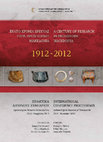
1912-2012: Εκατό Χρόνια Έρευνας στην Προϊστορική Μακεδονία , 2014
"After a hundred years of systematic, trial or accidental archaeological research in Prehistoric ... more "After a hundred years of systematic, trial or accidental archaeological research in Prehistoric Macedonia, no one can argue, anymore, that it constitutes a marginal province capable only for second class cultural achievements. Digging hundreds of holes, “public work” excavations have filled chronic gaps in the pre-historic map, whereas thousands of meticulous research reports have provided a considerably wider prism through which to view Macedonia’s prehistoric past. Notwithstanding the festive climate of the centennial, we should reflect on whether building an enhanced and constantly evolving archaeological discourse we have, in the same time, modified, deconstructed or broadened public’s perception of prehis-toric Macedonia. We should question whether we have attempted to constitute theoretical frameworks and elaborate practices in order to resist formalistic stereotypes, relinquish dubious cultural classifica-tions, and discuss with the “others” the significance of “little” things. We should, finally, ask ourselves whether we managed to make use of the dynamic potential that a historic narrative, free from gilded nationalistic presumptions, can offer.
This paper is an attempt to discuss the above focusing on prehistoric figurines, as a part of the archaeo-logical material record characterized by significant interpretative ambiguity, albeit evocative of emotion and “advantageous” museologically.
"
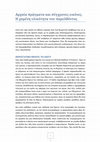
"Many things can be said about the obvious differences between the early outdated archaeological ... more "Many things can be said about the obvious differences between the early outdated archaeological museums and the recent flourishing in number and in technical innovation examples. Still, it can be argued that they all based on the same fundamental principle; their exhibition evolves around the vaguely determined aesthetic values and the self-evident historical significance of ancient objects. During the last decades, archaeology is scrutinising its objects and has repeatedly undermined and re-examined their interpretational role. However, in the same period, subversive museum attempts do not touch the objects themselves, and a typical exhibit includes archaeological finds that are incidentally characterized “unique”, “beautiful” or “representative”. In other words, musealised ancient things are stacked in a theoretical “no man’s land” that is affected neither by museological revolutions nor by archaeological reflexivity.
In an attempt to figure out some of the methodological reasons causing the detected museological awkwardness, this paper suggests that an inherent weakness of the whole procedure lies on the discrepancy between materiality, being the base of archaeological interpretational approach, as opposed to visuality that constitutes the dominating –if not the sole– frame for the museum experience. Almost all contemporary innovations are simply adding more visual elements around the de-materialised objects that are forced to function as mere images. This procedure not only subtracts layers of information, but, framing the material fragments of the past, obstructs the visitors’ creative elaboration and interpretation, as well. Following this line of thought, this paper suggests that we should reevaluate the visual impact of ancient objects and think of alternative ways to handle them either as arguments of a contemporary interpretation theory or as fragments of an undeciphered past. Either way, the question is whether we can reveal their materiality through the visual, and whether other sensory stimuli, such as sound, can lend us a hand.
"
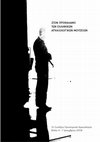
Prehistorians often complain that the archaeological record they produce is marginalized or even ... more Prehistorians often complain that the archaeological record they produce is marginalized or even ignored in Greek archaeological museums. This can be considered as the logical result of the marginal role prehistory has been playing, since 19th century, in the construction of Greek national identity, compared with the dominant role of posterior historical periods. Nevertheless, we should admit that, since some selected Bronze Age artifacts were accepted as primitive ancestors of the Greek classical masterpieces, their museal place was significantly upgraded. This especially applies to those assemblages that can easily attract the visitor’s attention either due to their un-scientific relation to the heroes of Greek Mythology or, simply, because of their valuable material. That explains the reason why prehistoric golden artifacts, with doubtful provenance and lacking any meaningful archaeological context, can easily find their way in “successful” exhibitions. That also explains why, centuries after the era of amateur collectors, contemporary archaeological museums select and exhibit prehistoric artifacts, such as Cycladic and Neolithic figurines, based mainly to their aesthetic qualities, overlooking the plethora of contemporary archaeological interpretative theories. In this line of thought, mundane, ordinary and “ugly” artifacts, such as flint blades or bone pins, are awkwardly presented and hardly ever can trap the visitor’s gaze.
In 1975, the revolutionary Neolithic Exhibition at Volos Archaeological Museum dared to break the rules: removed the glass cases, introduced new exhibition schemes and tried to organize the ancient objects not based on their artistic attributes but on their relation to specific human activities. After forty years, it appears that Greek archaeological exhibits haven’t managed to fruitfully absorb this heavy inheritance. The superficial reproductions of Volos museological techniques has led to a normative presentation of prehistoric cultures, where the museum narrative is limited to the description of generalized, universal, unrelated technical procedures: “how they cultivated”, “how they made their pots”, etc. We can suspect that well aware of the unappealing character of this unsurprising repetition, curators are not really eager to topple outdated –to say the least- archaeological constructions that are deeply embedded in popular mythologies, such as the Evansian interpretation of Knossos. Oddly enough, even when we don’t have to deal with this kind of “cemented” interpretations, prehistoric exhibitions show considerable inertia and reluctance to incorporate innovative archaeological narratives, conflicting views and multiple interpretations, insisting on an obsolete authoritative pedagogy.
In conclusion we can argue that today, when the by default conservative state ideological apparatuses are not determined to load every simple pottery sherd with political significance, prehistoric archaeology can be easily left with no social significance at all. It is in the hands of prehistorians to exit their sterile labs and conference halls, risk a conflicting contact with the public and build their contemporary progressive social role.
Ημερίδα για την Ιστορία της Αρχαιολογικής Υπηρεσίας και της Αρχαιολογικής Έρευνας στη Θεσσαλία Βό... more Ημερίδα για την Ιστορία της Αρχαιολογικής Υπηρεσίας και της Αρχαιολογικής Έρευνας στη Θεσσαλία Βόλος 17 Μαϊου 2010

Anaskamma 2, 2009
Monitoring public perceptions of an ongoing
archaeological project, although often discussed, is... more Monitoring public perceptions of an ongoing
archaeological project, although often discussed, is
still a marginal activity suppressed by the excavation
and laboratory routines. The problem remains even
if the research team is strongly oriented towards the
broadest possible dissemination of the archaeological
information, as in the case of Dispilio, a Neolithic
lake-side settlement in Northern Greece.
We have realized that, far from being interested
in the research aims/objectives of our
work, the locals determine their attitude based
on a continuous assessment of the value of our
“product”, either this is an economic value (as it
is understood by the person renting rooms, selling
food, the workers, the landowners, the shepherds,
the ishermen) or an ideological one (as
it is understood by the local priest that rejects
every un-Christian piece of work and needs the
excavation site for church festivities, the Mayor
that hopes to be re-elected, the politicians that
elaborate their cultural policies, every member
of the community and the community as a whole
that uses our product to formulate their collective
identity) or even both.
On the other hand, talking to the visitors we realize
that, regardless our explanatory efforts (the
guided tours offered, brief lealets, guide books
etc), a communication gap actually exists and as
the visitors’ number increases we have the feeling
that the gap gets wider. The approving remarks or
the lattering comments are rarely based on the
focal points of our endeavor and hardly ever take
into consideration our interpretations.
The visitor’s book that is capturing some of
these impressions since 1996, can offer an evaluation
tool. Needless to say that the sample we have
–as a percentage of the whole number of visitorsmay
not be quite representative and the written
comments do not constitute the most explicit way
of expression. Nevertheless, closer examination
can reveal some interesting issues for further
elaboration.
Public Archaeology 8(2-3), 2009
Monitoring public perceptions of an ongoing archaeological project, although often discussed, is ... more Monitoring public perceptions of an ongoing archaeological project, although often discussed, is still a marginal activity, overshadowed by excavation and laboratory routines. The problem remains even if the research team is strongly orientated towards the broadest possible dissemination of the archaeological information, as in the case of Dispilio, a Neolithic lakeside settlement in northern Greece. A visitors’ book, kept since 1996,
illustrates in a colourful way the visitors’ impressions, offering at the same time a glimpse of the complex mechanisms that forge these impressions.
Moreover, a close examination of the written comments makes it clear that there is much more to be ‘read’ underneath their bvious flattering remarks, and that they should be incorporated in a more systematic ethnographic study of the archaeological visit’s performance.










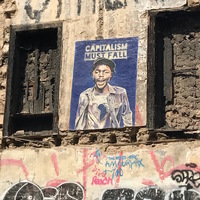
Uploads
Papers by Anastasia Chourmouziadi
Το κείμενο αυτό, συνδυάζοντας τα στοιχεία μελετών που αφορούν επιμέρους φωτογραφίες, σύνολα και εκθέσεις, επιχειρεί ένα γενικό σχολιασμό των εικόνων της προσφυγικής κρίσης και το πώς αυτές πλαισιώνουν το ζήτημα.
character of archaeology, as a tool of modernity. The Greek case, constituting one of the most typical examples, has been thoroughly discussed. Nevertheless, the great majority of these texts have a, more or less, historical orientation, focusing on the procedures that led to the formation of the modern Greek state and on the 19th and early 20th century archaeological activity that supported the construction of Greek national narrative. In the text that follows, I attempt to briefly outline the basic features of the political economy of Greek archaeology, as it is exercised today, by the state services, the academia, and all those that, although deprived of an official archaeological position, still consider themselves archaeologists.
Σήμερα, λοιπόν, σε συνθήκες μιας κρίσης που ολοένα και βαθαίνει, δημιουργώντας –ανάμεσα στα άλλα- την ελπίδα μιας ολόπλευρης ρήξης με τις δομές που μας οδήγησαν σε αυτή, τι θα κάνουμε με τα μουσεία; Υπάρχει περιθώριο να τα χρησιμοποιήσουμε ως πεδίο συλλογικής διαπραγμάτευσης του παρελθόντος και μοχλό κοινωνικής αφύπνισης, ή θα πρέπει να τα γκρεμίσουμε, όπως τη Βαστίλη, για να απελευθερώσουμε τις υλικές και άυλες μνήμες από τα ιδεολογικά δεσμά του «παλιού καθεστώτος»;
This paper is an attempt to discuss the above focusing on prehistoric figurines, as a part of the archaeo-logical material record characterized by significant interpretative ambiguity, albeit evocative of emotion and “advantageous” museologically.
"
In an attempt to figure out some of the methodological reasons causing the detected museological awkwardness, this paper suggests that an inherent weakness of the whole procedure lies on the discrepancy between materiality, being the base of archaeological interpretational approach, as opposed to visuality that constitutes the dominating –if not the sole– frame for the museum experience. Almost all contemporary innovations are simply adding more visual elements around the de-materialised objects that are forced to function as mere images. This procedure not only subtracts layers of information, but, framing the material fragments of the past, obstructs the visitors’ creative elaboration and interpretation, as well. Following this line of thought, this paper suggests that we should reevaluate the visual impact of ancient objects and think of alternative ways to handle them either as arguments of a contemporary interpretation theory or as fragments of an undeciphered past. Either way, the question is whether we can reveal their materiality through the visual, and whether other sensory stimuli, such as sound, can lend us a hand.
"
In 1975, the revolutionary Neolithic Exhibition at Volos Archaeological Museum dared to break the rules: removed the glass cases, introduced new exhibition schemes and tried to organize the ancient objects not based on their artistic attributes but on their relation to specific human activities. After forty years, it appears that Greek archaeological exhibits haven’t managed to fruitfully absorb this heavy inheritance. The superficial reproductions of Volos museological techniques has led to a normative presentation of prehistoric cultures, where the museum narrative is limited to the description of generalized, universal, unrelated technical procedures: “how they cultivated”, “how they made their pots”, etc. We can suspect that well aware of the unappealing character of this unsurprising repetition, curators are not really eager to topple outdated –to say the least- archaeological constructions that are deeply embedded in popular mythologies, such as the Evansian interpretation of Knossos. Oddly enough, even when we don’t have to deal with this kind of “cemented” interpretations, prehistoric exhibitions show considerable inertia and reluctance to incorporate innovative archaeological narratives, conflicting views and multiple interpretations, insisting on an obsolete authoritative pedagogy.
In conclusion we can argue that today, when the by default conservative state ideological apparatuses are not determined to load every simple pottery sherd with political significance, prehistoric archaeology can be easily left with no social significance at all. It is in the hands of prehistorians to exit their sterile labs and conference halls, risk a conflicting contact with the public and build their contemporary progressive social role.
archaeological project, although often discussed, is
still a marginal activity suppressed by the excavation
and laboratory routines. The problem remains even
if the research team is strongly oriented towards the
broadest possible dissemination of the archaeological
information, as in the case of Dispilio, a Neolithic
lake-side settlement in Northern Greece.
We have realized that, far from being interested
in the research aims/objectives of our
work, the locals determine their attitude based
on a continuous assessment of the value of our
“product”, either this is an economic value (as it
is understood by the person renting rooms, selling
food, the workers, the landowners, the shepherds,
the ishermen) or an ideological one (as
it is understood by the local priest that rejects
every un-Christian piece of work and needs the
excavation site for church festivities, the Mayor
that hopes to be re-elected, the politicians that
elaborate their cultural policies, every member
of the community and the community as a whole
that uses our product to formulate their collective
identity) or even both.
On the other hand, talking to the visitors we realize
that, regardless our explanatory efforts (the
guided tours offered, brief lealets, guide books
etc), a communication gap actually exists and as
the visitors’ number increases we have the feeling
that the gap gets wider. The approving remarks or
the lattering comments are rarely based on the
focal points of our endeavor and hardly ever take
into consideration our interpretations.
The visitor’s book that is capturing some of
these impressions since 1996, can offer an evaluation
tool. Needless to say that the sample we have
–as a percentage of the whole number of visitorsmay
not be quite representative and the written
comments do not constitute the most explicit way
of expression. Nevertheless, closer examination
can reveal some interesting issues for further
elaboration.
illustrates in a colourful way the visitors’ impressions, offering at the same time a glimpse of the complex mechanisms that forge these impressions.
Moreover, a close examination of the written comments makes it clear that there is much more to be ‘read’ underneath their bvious flattering remarks, and that they should be incorporated in a more systematic ethnographic study of the archaeological visit’s performance.
Το κείμενο αυτό, συνδυάζοντας τα στοιχεία μελετών που αφορούν επιμέρους φωτογραφίες, σύνολα και εκθέσεις, επιχειρεί ένα γενικό σχολιασμό των εικόνων της προσφυγικής κρίσης και το πώς αυτές πλαισιώνουν το ζήτημα.
character of archaeology, as a tool of modernity. The Greek case, constituting one of the most typical examples, has been thoroughly discussed. Nevertheless, the great majority of these texts have a, more or less, historical orientation, focusing on the procedures that led to the formation of the modern Greek state and on the 19th and early 20th century archaeological activity that supported the construction of Greek national narrative. In the text that follows, I attempt to briefly outline the basic features of the political economy of Greek archaeology, as it is exercised today, by the state services, the academia, and all those that, although deprived of an official archaeological position, still consider themselves archaeologists.
Σήμερα, λοιπόν, σε συνθήκες μιας κρίσης που ολοένα και βαθαίνει, δημιουργώντας –ανάμεσα στα άλλα- την ελπίδα μιας ολόπλευρης ρήξης με τις δομές που μας οδήγησαν σε αυτή, τι θα κάνουμε με τα μουσεία; Υπάρχει περιθώριο να τα χρησιμοποιήσουμε ως πεδίο συλλογικής διαπραγμάτευσης του παρελθόντος και μοχλό κοινωνικής αφύπνισης, ή θα πρέπει να τα γκρεμίσουμε, όπως τη Βαστίλη, για να απελευθερώσουμε τις υλικές και άυλες μνήμες από τα ιδεολογικά δεσμά του «παλιού καθεστώτος»;
This paper is an attempt to discuss the above focusing on prehistoric figurines, as a part of the archaeo-logical material record characterized by significant interpretative ambiguity, albeit evocative of emotion and “advantageous” museologically.
"
In an attempt to figure out some of the methodological reasons causing the detected museological awkwardness, this paper suggests that an inherent weakness of the whole procedure lies on the discrepancy between materiality, being the base of archaeological interpretational approach, as opposed to visuality that constitutes the dominating –if not the sole– frame for the museum experience. Almost all contemporary innovations are simply adding more visual elements around the de-materialised objects that are forced to function as mere images. This procedure not only subtracts layers of information, but, framing the material fragments of the past, obstructs the visitors’ creative elaboration and interpretation, as well. Following this line of thought, this paper suggests that we should reevaluate the visual impact of ancient objects and think of alternative ways to handle them either as arguments of a contemporary interpretation theory or as fragments of an undeciphered past. Either way, the question is whether we can reveal their materiality through the visual, and whether other sensory stimuli, such as sound, can lend us a hand.
"
In 1975, the revolutionary Neolithic Exhibition at Volos Archaeological Museum dared to break the rules: removed the glass cases, introduced new exhibition schemes and tried to organize the ancient objects not based on their artistic attributes but on their relation to specific human activities. After forty years, it appears that Greek archaeological exhibits haven’t managed to fruitfully absorb this heavy inheritance. The superficial reproductions of Volos museological techniques has led to a normative presentation of prehistoric cultures, where the museum narrative is limited to the description of generalized, universal, unrelated technical procedures: “how they cultivated”, “how they made their pots”, etc. We can suspect that well aware of the unappealing character of this unsurprising repetition, curators are not really eager to topple outdated –to say the least- archaeological constructions that are deeply embedded in popular mythologies, such as the Evansian interpretation of Knossos. Oddly enough, even when we don’t have to deal with this kind of “cemented” interpretations, prehistoric exhibitions show considerable inertia and reluctance to incorporate innovative archaeological narratives, conflicting views and multiple interpretations, insisting on an obsolete authoritative pedagogy.
In conclusion we can argue that today, when the by default conservative state ideological apparatuses are not determined to load every simple pottery sherd with political significance, prehistoric archaeology can be easily left with no social significance at all. It is in the hands of prehistorians to exit their sterile labs and conference halls, risk a conflicting contact with the public and build their contemporary progressive social role.
archaeological project, although often discussed, is
still a marginal activity suppressed by the excavation
and laboratory routines. The problem remains even
if the research team is strongly oriented towards the
broadest possible dissemination of the archaeological
information, as in the case of Dispilio, a Neolithic
lake-side settlement in Northern Greece.
We have realized that, far from being interested
in the research aims/objectives of our
work, the locals determine their attitude based
on a continuous assessment of the value of our
“product”, either this is an economic value (as it
is understood by the person renting rooms, selling
food, the workers, the landowners, the shepherds,
the ishermen) or an ideological one (as
it is understood by the local priest that rejects
every un-Christian piece of work and needs the
excavation site for church festivities, the Mayor
that hopes to be re-elected, the politicians that
elaborate their cultural policies, every member
of the community and the community as a whole
that uses our product to formulate their collective
identity) or even both.
On the other hand, talking to the visitors we realize
that, regardless our explanatory efforts (the
guided tours offered, brief lealets, guide books
etc), a communication gap actually exists and as
the visitors’ number increases we have the feeling
that the gap gets wider. The approving remarks or
the lattering comments are rarely based on the
focal points of our endeavor and hardly ever take
into consideration our interpretations.
The visitor’s book that is capturing some of
these impressions since 1996, can offer an evaluation
tool. Needless to say that the sample we have
–as a percentage of the whole number of visitorsmay
not be quite representative and the written
comments do not constitute the most explicit way
of expression. Nevertheless, closer examination
can reveal some interesting issues for further
elaboration.
illustrates in a colourful way the visitors’ impressions, offering at the same time a glimpse of the complex mechanisms that forge these impressions.
Moreover, a close examination of the written comments makes it clear that there is much more to be ‘read’ underneath their bvious flattering remarks, and that they should be incorporated in a more systematic ethnographic study of the archaeological visit’s performance.
http://museologylab.ct.aegean.gr/mais.pdf?fbclid=IwAR0eFa11V-3IknsQK4HSzpG4oI0_ubhN2TsiUMyyzl7hfWL61mx8cgvetec
Σκέψεις, προβληματισμοί και ιδέες γύρω από τη μνημονική διαχείριση των γεγονότων του Μάη και τους τρόπους που εκτίθενται τα κοινωνικά κινήματα, τα διαθέσιμα αφηγηματικά εργαλεία που χρησιμοποιήσαμε και αναλυτική παρουσίαση της έκθεσής μας "Κάτω από τους Κυβόλιθους. Εκθέτοντας τον Μάη του '68" (συνδιοργάνωση Εργαστηρίου Μουσειολογίας-Museolab και Μεταπτυχιακού Προγράμματος Μουσειολογίας, Πανεπιστημίου Αιγαίου, 2019).
Thoughts, questions and ideas concerning the ways May '68 and the social movements are being exhibited, the tools we used in narrating the exhibition and detailed presentation of our 2019 exhibition "Under the cobblestones. Exhibiting May '68" (co-organised by Museolab-Museology Laboratory and MSc of Cultural Informatics and Communication-Museology, University of the Aegean)(in Greek)